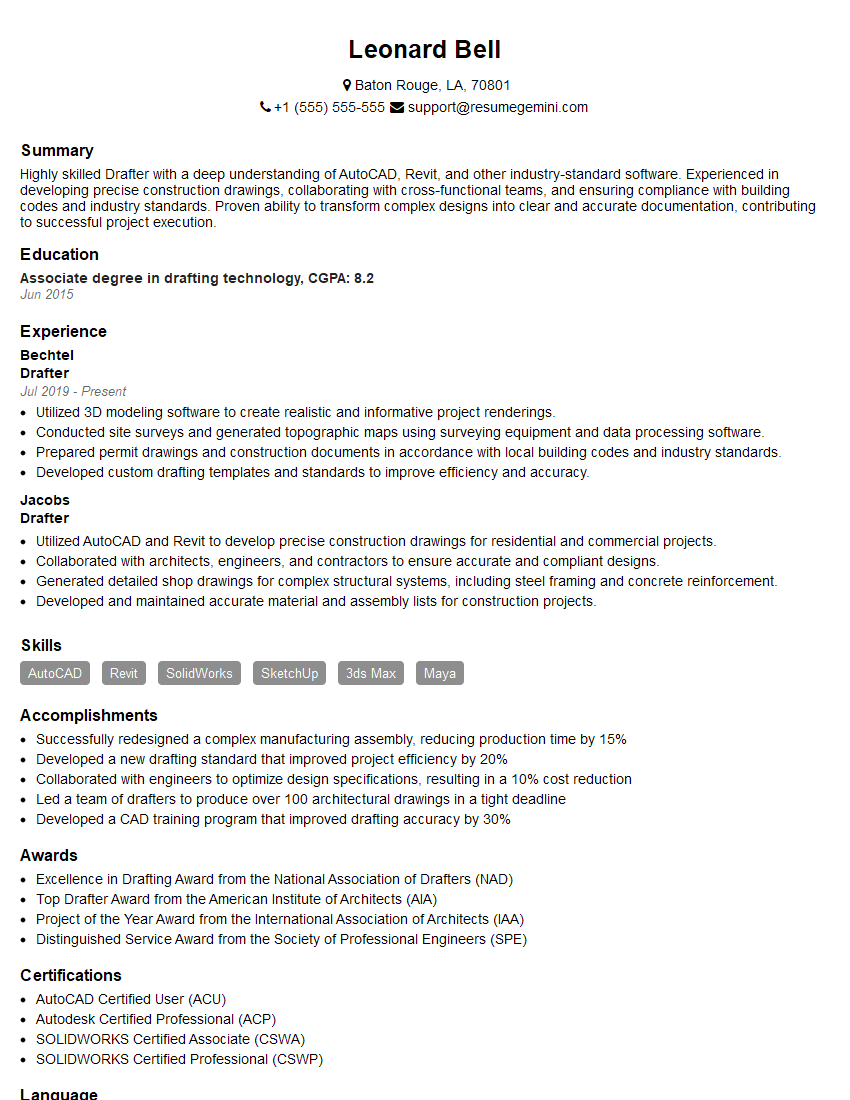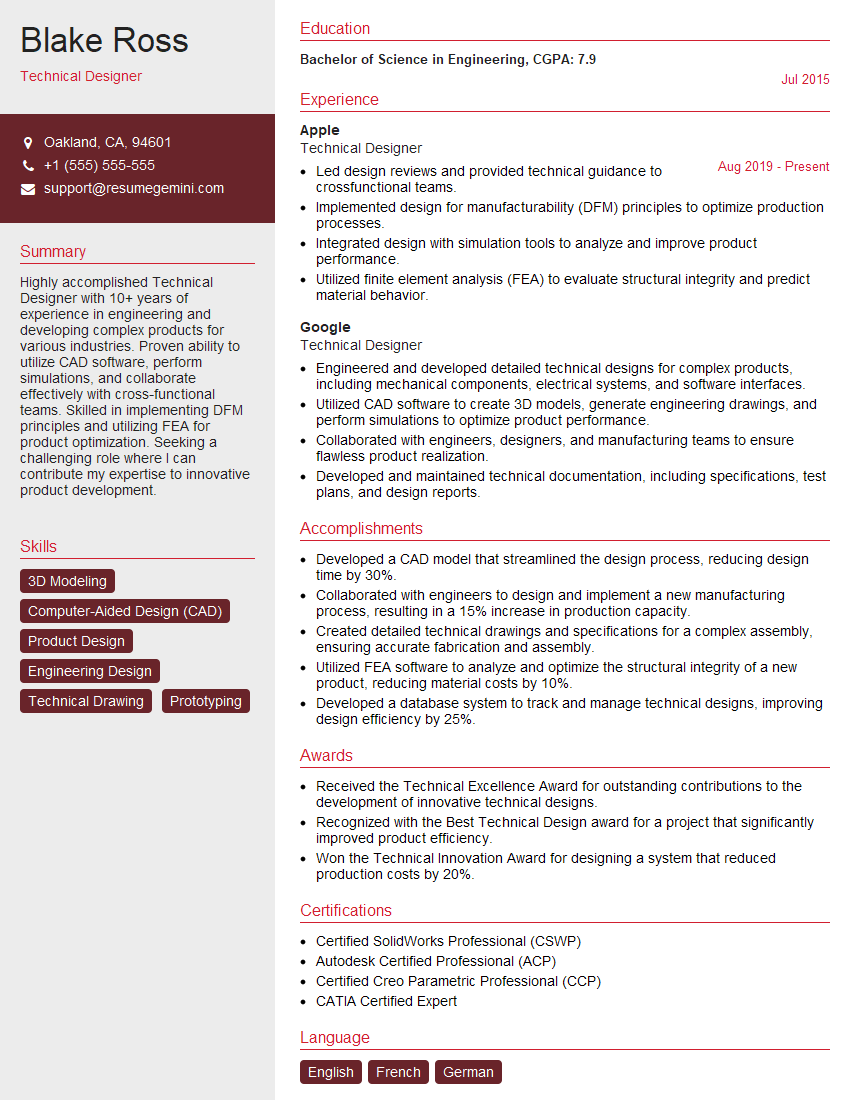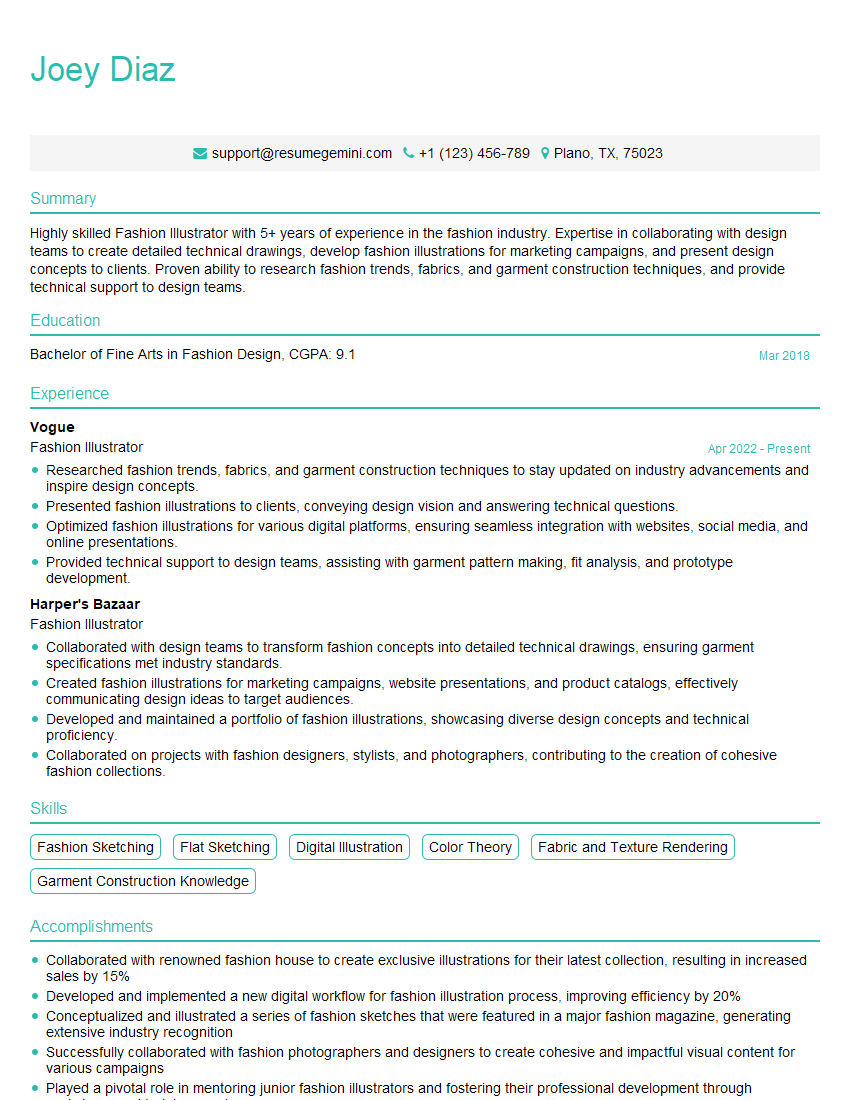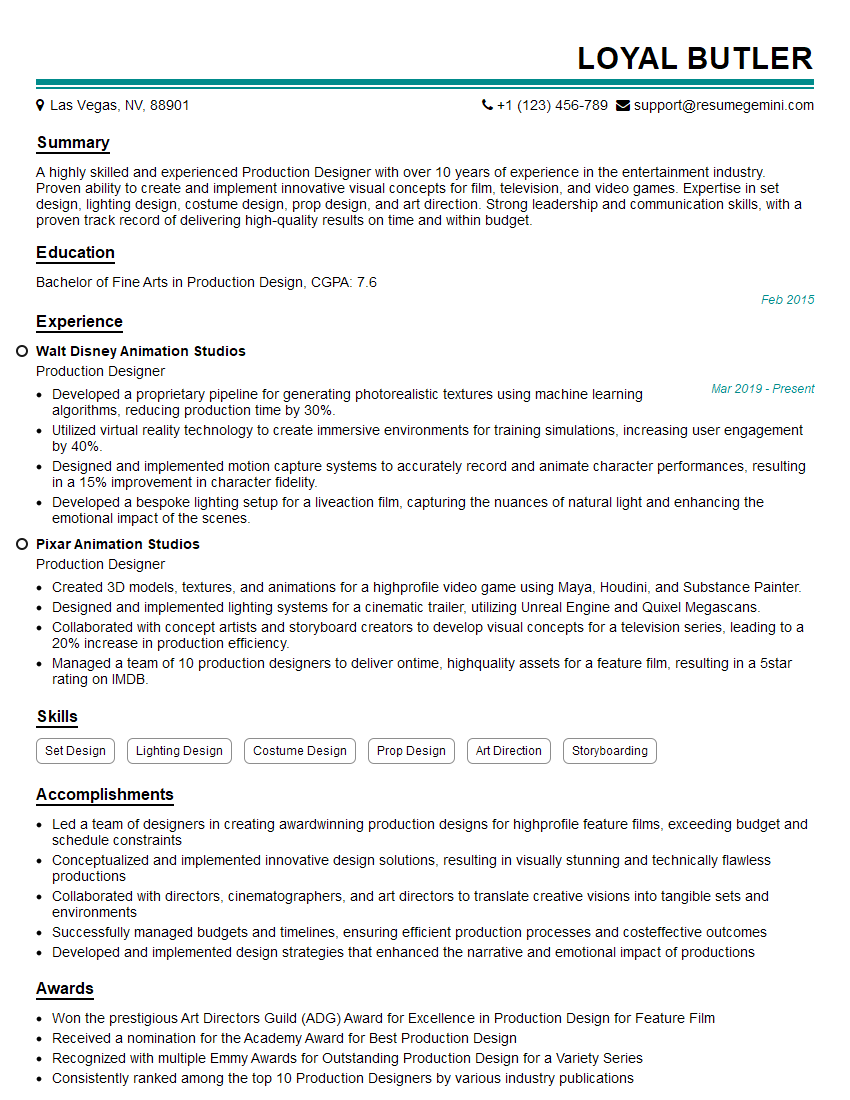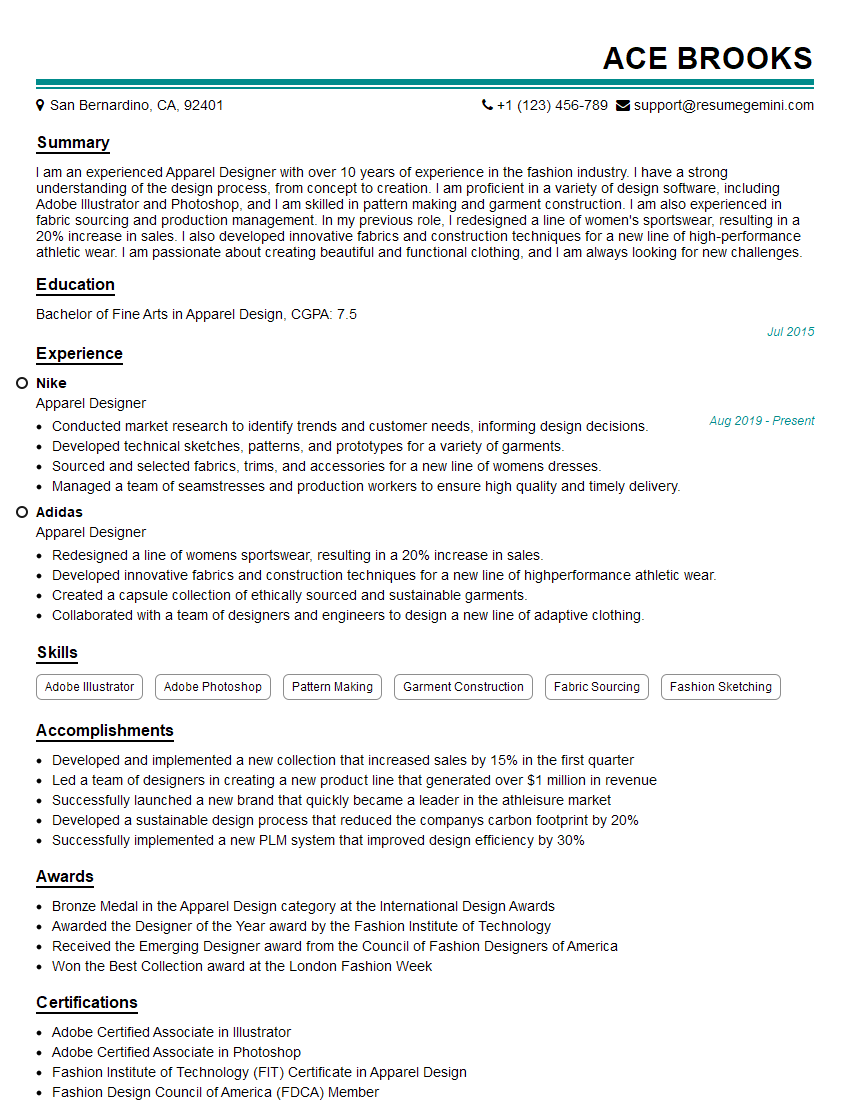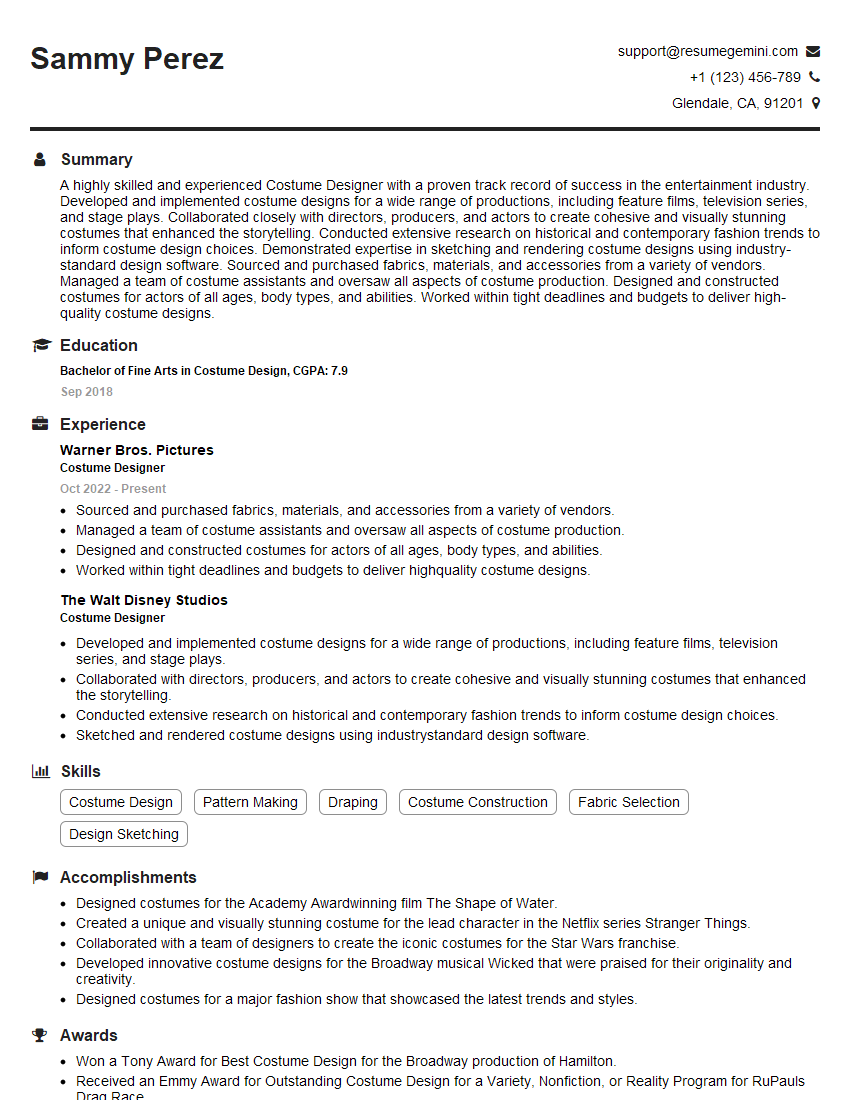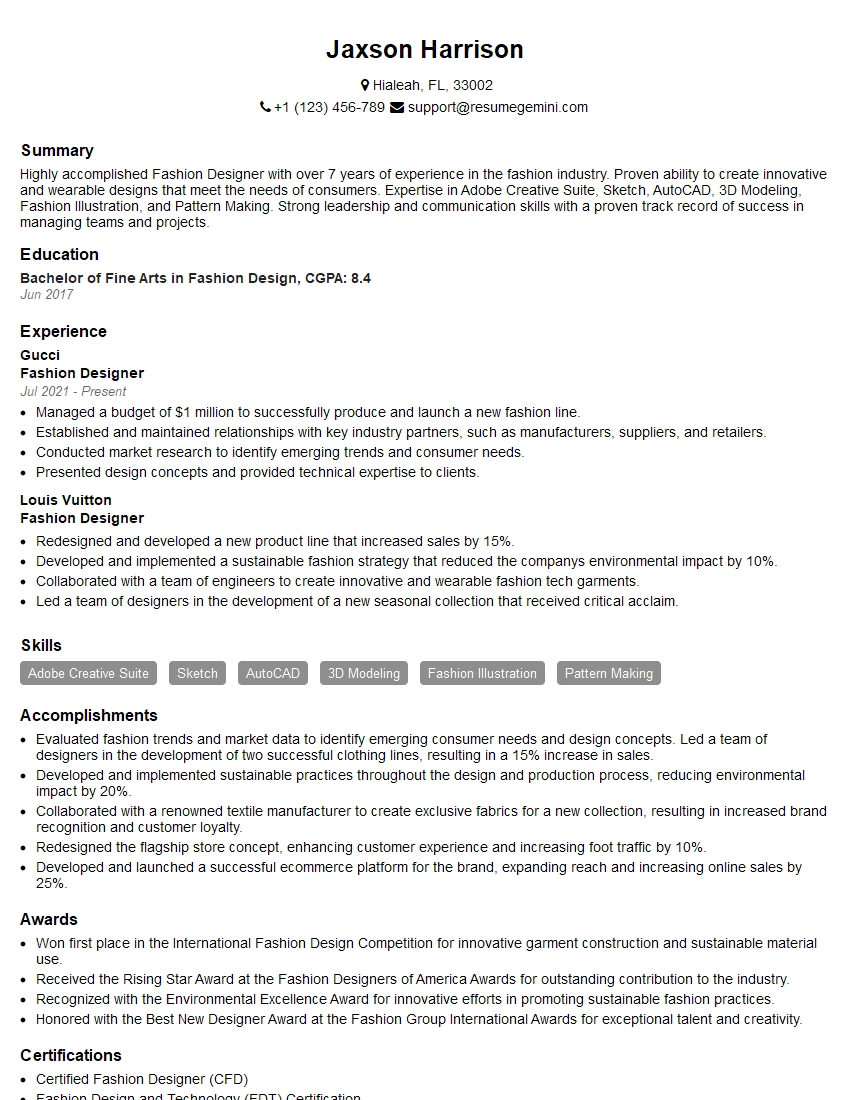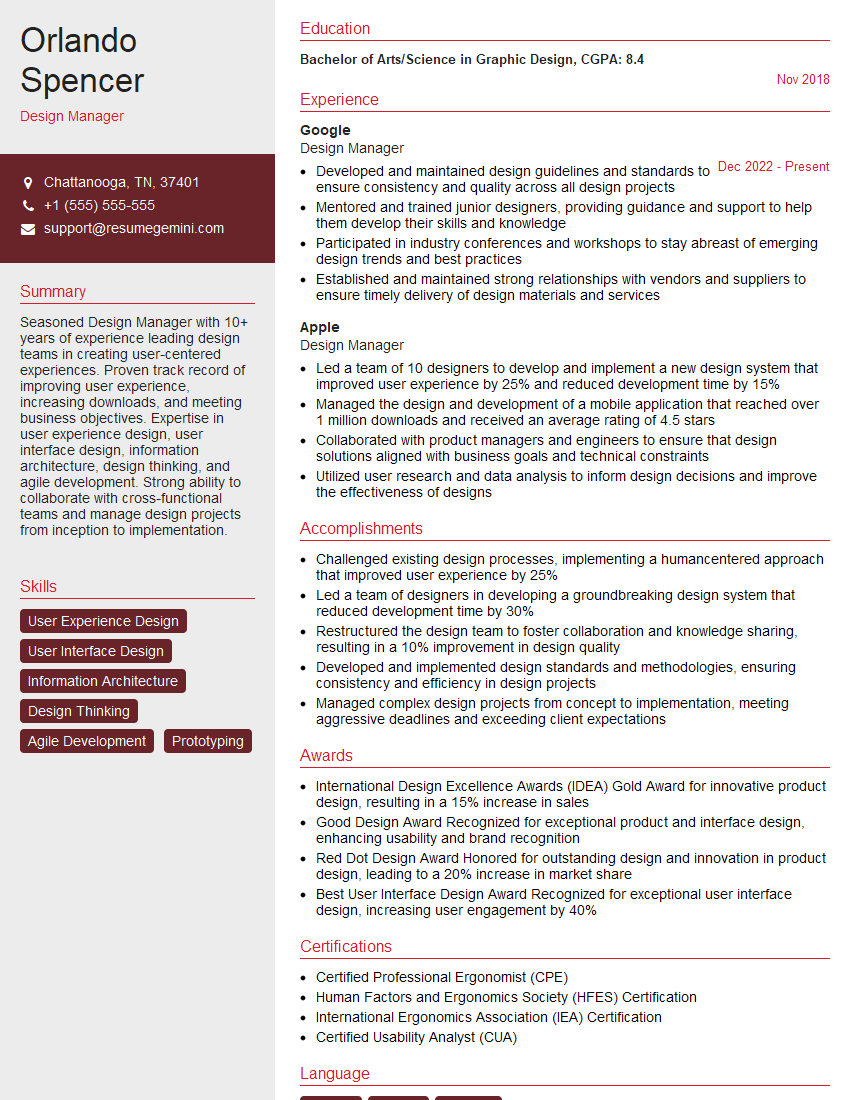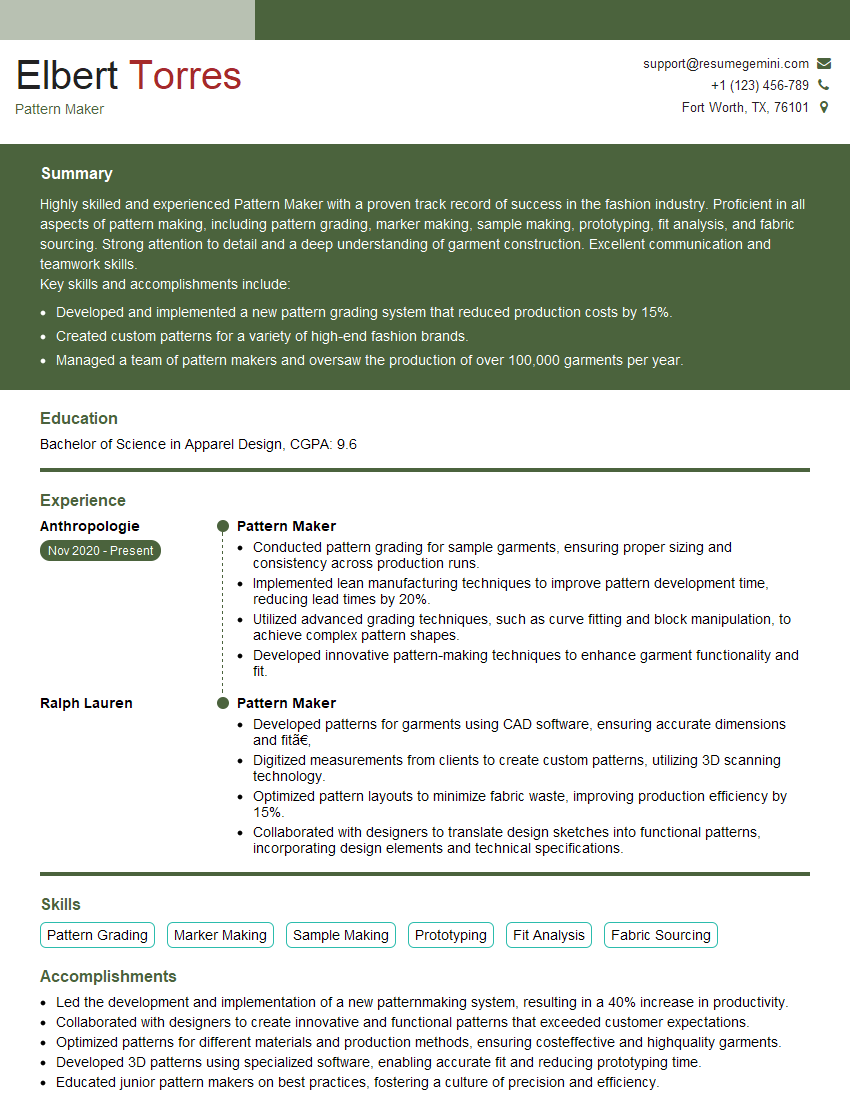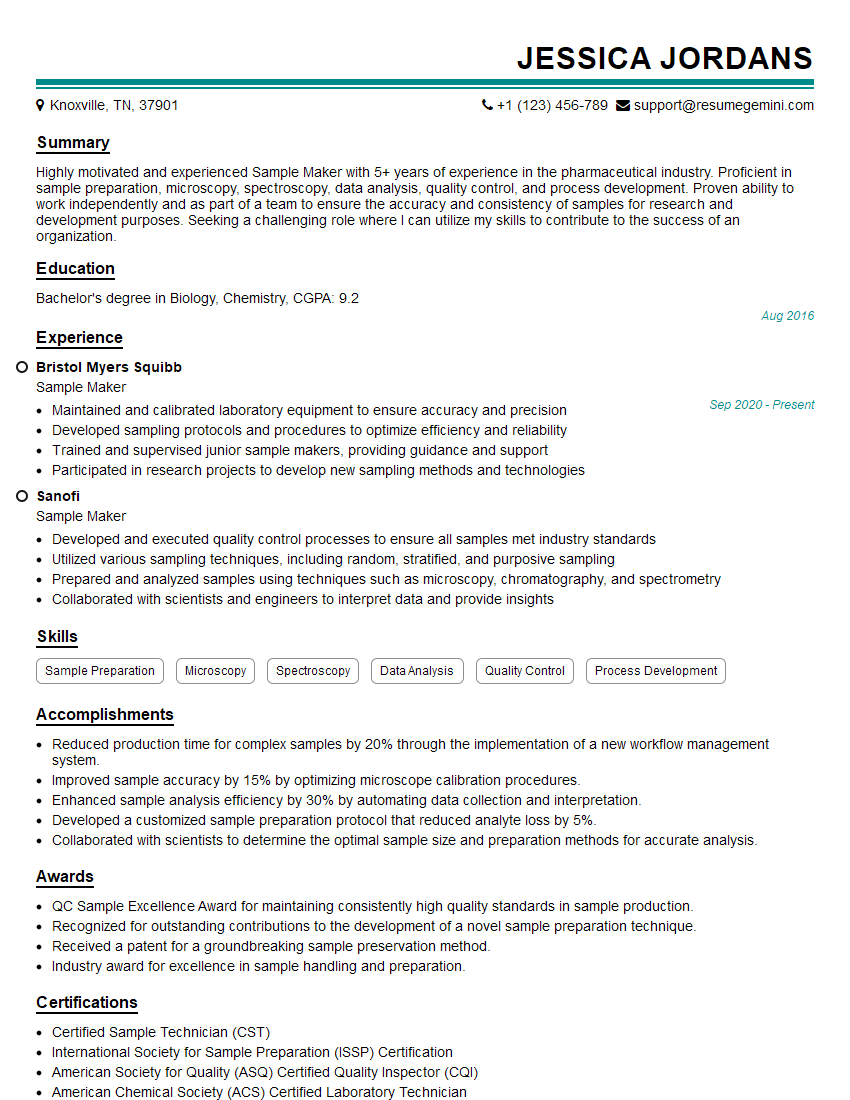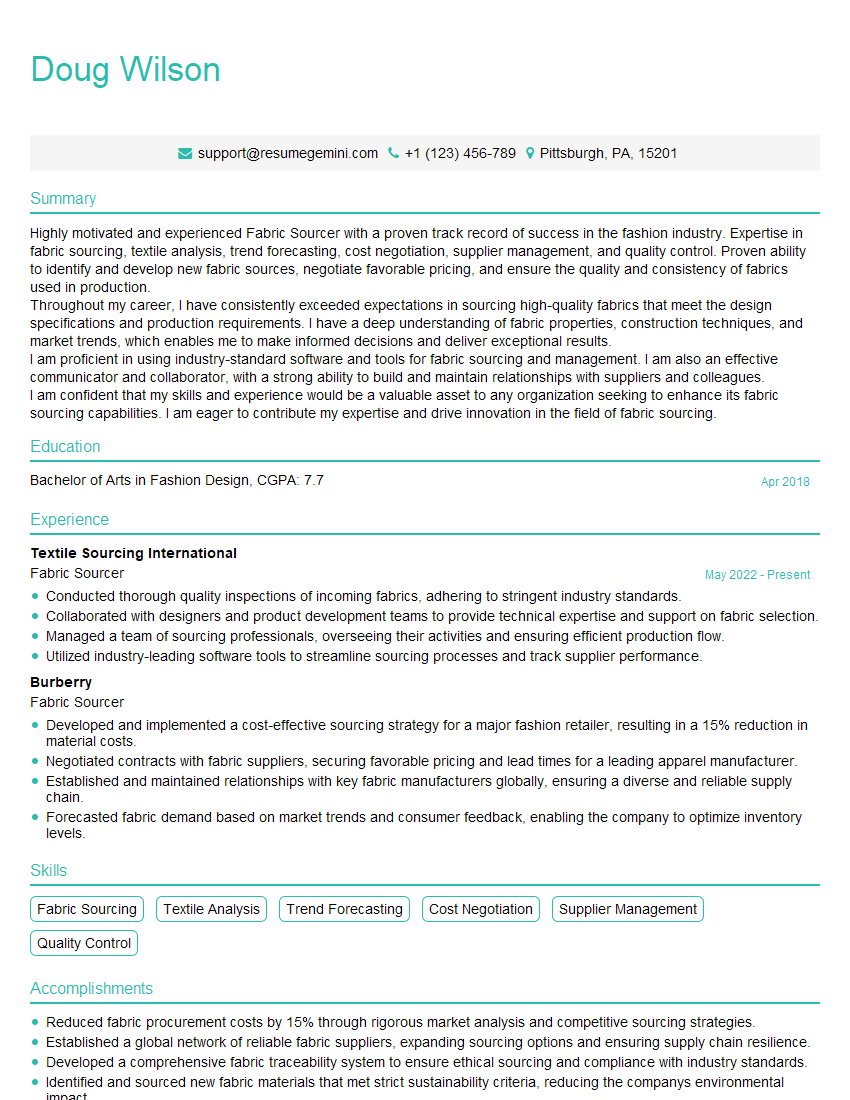The right preparation can turn an interview into an opportunity to showcase your expertise. This guide to Fashion Design Basics interview questions is your ultimate resource, providing key insights and tips to help you ace your responses and stand out as a top candidate.
Questions Asked in Fashion Design Basics Interview
Q 1. Explain the difference between a dart and a seam.
While both darts and seams contribute to shaping and construction in garment making, they differ significantly in their function and appearance. A seam is the line of stitching where two or more pieces of fabric are joined together. It’s a fundamental element used for construction, creating structure, and adding length or width. Think of the side seams of a dress or the shoulder seams of a shirt – those are all seams.
A dart, on the other hand, is a folded, stitched section of fabric used to shape the garment and create curves or form-fitting silhouettes. It’s essentially a controlled way to add three-dimensional shape without adding bulk. Darts are often found on busts, waists, or sleeves to tailor the garment to the body’s curves. For example, a dart at the bust of a blouse will shape it to fit the chest perfectly, as opposed to a straight, boxy shape.
In short: seams join fabric pieces, while darts shape the individual fabric pieces. They often work together – a seam might join two pieces that already have darts shaped into them.
Q 2. Describe the process of creating a mood board.
Creating a mood board is a crucial first step in the design process. It’s a visual representation of the overall aesthetic and feeling you want to achieve for a particular garment or collection. It’s like a brainstorming session brought to life!
The process typically involves gathering images, textures, colors, and even fabric swatches that inspire you. You can source these from magazines, online platforms like Pinterest, or even your own personal collection. Then, arrange these elements on a board (physical or digital) in a way that communicates the design direction. Consider using a consistent theme or color palette to create a cohesive look.
For example, if I’m designing a spring collection inspired by nature, my mood board might feature images of blossoming flowers, lush green landscapes, and pastel color swatches. I might even include texture samples of lightweight fabrics like linen or silk to convey the feel of the collection. The goal is to create a visual story that guides the design process.
Q 3. What are the different types of fabric weaves?
Fabric weaves refer to the method by which yarns are interlaced to create a fabric. Different weave structures result in fabrics with varying characteristics in terms of drape, texture, strength, and durability.
- Plain Weave: The simplest weave, where the warp (vertical) and weft (horizontal) yarns interlace in an over-one-under-one pattern. This creates a balanced, relatively strong, and versatile fabric, such as cotton shirting or calico.
- Twill Weave: Characterized by a diagonal pattern created by the floating of weft yarns over two or more warp yarns. This results in a stronger, more durable fabric with a distinctive diagonal texture. Denim and gabardine are examples of twill weaves.
- Satin Weave: Creates a smooth, lustrous surface by having long floats of warp yarns on the surface. It is less durable than twill or plain weaves but offers an elegant, luxurious drape. Satin and charmeuse are examples.
- Knit Weave: Not technically a weave but rather a structure made by interlocking loops of yarn. Knit fabrics are flexible, stretchy, and relatively lightweight. Examples include jersey and rib knit.
Understanding different weave structures is critical for selecting appropriate fabrics for garment construction, since each offers different properties suitable for different design applications.
Q 4. How do you choose appropriate fabrics for different garments?
Choosing appropriate fabrics is crucial for garment success. Consider these key factors:
- Garment type: A flowing summer dress requires a lightweight, breathable fabric like cotton voile or linen, whereas a winter coat needs a warm, heavy fabric such as wool or fleece.
- Intended use: A garment for everyday wear might call for a durable, easy-care fabric like polyester, while a formal gown might demand a luxurious, delicate fabric such as silk or velvet.
- Season: Fabrics should be chosen based on the climate and season the garment will be worn in. Summer garments need breathable fabrics, while winter garments need warm, insulating ones.
- Drape and texture: The desired drape and texture will heavily influence fabric choice. A structured garment requires a fabric with good body, while a flowing garment needs a drapey fabric.
- Maintenance and care: Consider the fabric’s ease of care and durability. Fabrics that require special cleaning might not be practical for certain garments.
For example, when designing a tailored business suit, I would likely choose a medium-weight wool fabric for its structure, drape, and professional appearance. For a summer blouse, I would consider a lightweight cotton or linen, prioritizing breathability and comfort.
Q 5. Explain the importance of pattern making in garment construction.
Pattern making is the foundation of garment construction. It’s the process of creating a two-dimensional template (the pattern) that, when cut and sewn, forms a three-dimensional garment. It’s essentially the blueprint for a garment.
The accuracy of the pattern is critical to the fit, shape, and overall quality of the finished garment. A well-constructed pattern ensures proper proportions and eases, resulting in a garment that fits and hangs well. Without a good pattern, even the most beautiful fabric and skillful sewing won’t create a well-fitting garment. Pattern making is often iterative – requiring adjustments and refinements based on fittings and the designer’s vision.
In practice, pattern making involves a combination of drafting (creating a pattern from measurements), draping (creating a pattern by shaping fabric on a mannequin), and pattern alteration techniques to achieve the desired fit and style. Mastering pattern making is essential for any serious fashion designer, allowing for both precise design execution and the ability to customize designs easily.
Q 6. Describe your experience with CAD software (e.g., Illustrator, Photoshop).
I have extensive experience using CAD software, primarily Adobe Illustrator and Photoshop. Illustrator is my go-to for creating technical drawings, pattern pieces, and flats. Its precision tools are perfect for creating accurate and detailed representations of my designs. I use its vector capabilities to ensure scalability without loss of quality.
Photoshop, on the other hand, is invaluable for creating mood boards, color palettes, and adding texture and visual effects to design presentations. I use its layering capabilities to build complex illustrations and manipulate images to achieve the desired aesthetic.
For example, I recently used Illustrator to create a detailed technical flat for a new jacket design, including seam lines, darts, and precise measurements. Then, I used Photoshop to create a photorealistic rendering of the jacket on a model, complete with realistic textures and lighting effects. This allowed me to present a comprehensive visual to my client before production began.
Q 7. What are the key elements of good design?
Good design encompasses several key elements:
- Functionality: The garment should be functional and serve its intended purpose. It should be comfortable, durable, and easy to wear.
- Aesthetics: The design should be visually appealing and communicate a clear aesthetic message. This involves thoughtful consideration of color, texture, silhouette, and detail.
- Originality: The design should be unique and stand out from the crowd. It should offer something fresh or innovative.
- Proportion and Balance: The different elements of the garment should be in proportion to each other and balanced visually. This creates harmony and visual appeal.
- Craftsmanship: The garment should be well-made with attention to detail. Quality construction adds to the overall value and longevity of the garment.
Essentially, a good design seamlessly blends form and function, creating a garment that is both beautiful and practical. It’s a delicate balance that requires both creative vision and technical skill.
Q 8. How do you incorporate sustainability into your designs?
Sustainability is paramount in modern fashion design. It’s not just a trend; it’s a responsibility. I incorporate sustainable practices throughout the design process, from initial concept to final production.
- Material Selection: I prioritize eco-friendly fabrics like organic cotton, Tencel (a sustainable wood-based fiber), recycled materials, and innovative alternatives such as Piñatex (made from pineapple leaf fibers). I carefully research the environmental impact of each fabric, considering its production process, water usage, and overall carbon footprint.
- Minimalist Design: I focus on creating timeless, versatile pieces that avoid fleeting trends. This reduces the likelihood of garments ending up in landfills after only a short period of wear. Less is more, both aesthetically and environmentally.
- Production Methods: I collaborate with ethical and responsible manufacturers who prioritize fair labor practices and minimize waste during the production process. This includes exploring techniques like zero-waste pattern cutting to reduce fabric scraps.
- Durability and Longevity: I design garments built to last. High-quality construction, durable stitching, and the use of robust fabrics ensure the garment’s longevity, minimizing the need for frequent replacements.
- Circular Design: I explore design concepts that allow for easy disassembly and recycling or repurposing at the end of the garment’s life. This thinking encourages a closed-loop system within the fashion industry.
For example, in a recent collection, I used recycled plastic bottles to create a surprisingly soft and durable fabric for a line of outerwear. The result was a fashionable, functional, and environmentally conscious product.
Q 9. Explain the different types of closures used in garments.
Garment closures are crucial for both functionality and aesthetics. They can significantly impact the overall look and feel of a garment. Here are some common types:
- Zippers: Versatile and widely used, available in various materials (metal, plastic), colors, and styles (visible, concealed). They offer a secure and adjustable closure.
- Buttons: Classic and diverse, ranging from simple plastic buttons to intricate handcrafted ones. They can be sewn on or attached with button shanks. Buttonholes are created using various techniques.
- Hooks and Eyes: Small, usually metal, fasteners providing a secure closure, often used in conjunction with zippers or other closures.
- Snaps: Pressure-fasteners, convenient and quick to use, common in shirts, trousers, and children’s clothing.
- Velcro: A hook-and-loop fastener, widely used for its easy and secure fastening, often found in sportswear and children’s wear.
- Buckles: Used for belts, straps, bags, and certain types of outerwear. They add a structural and decorative element.
- Drawstrings: Used for waistlines, hoods, or necklines, offering a relaxed and adjustable closure.
- Toggles: Used with cords or straps for adjustable closures.
Choosing the right closure depends on the garment’s style, function, and target audience. For instance, a formal dress might use a concealed zipper and hooks and eyes, while a casual shirt might use buttons.
Q 10. What are your preferred sketching techniques?
My sketching style is a blend of technical accuracy and artistic expression. I primarily use a combination of techniques to capture my ideas effectively.
- Croquis: I start with a basic croquis, a template of a stylized figure, which helps maintain consistent proportions across sketches. This speeds up the sketching process and allows me to focus on design details.
- Pencil Sketching: I use different grades of pencils to create varied line weights and shading. Light pencil strokes for initial ideas and darker strokes for defining details. I often use a kneaded eraser to lift and refine lines.
- Watercolor Rendering: I sometimes add watercolor washes to my pencil sketches to create a more complete visualization of the fabric and color palette. This helps me to better understand how the fabrics will drape and interact.
- Digital Sketching: I use digital sketching tools to create cleaner, more polished designs and explore different variations quickly. This allows for easy modification and sharing.
I find that combining traditional and digital techniques allows me the freedom to explore quickly and refine the details effectively.
Q 11. How would you address a design challenge with limited resources?
Resource limitations are a common challenge in fashion design. My approach involves prioritizing creativity and resourcefulness:
- Innovative Material Sourcing: I explore alternative, cost-effective materials that might be readily available or repurposed. This could involve using upcycled fabrics, deadstock materials, or locally sourced resources.
- Simplified Construction: I streamline the design by minimizing complex construction techniques and embellishments. This reduces labor costs and material waste.
- Streamlined Pattern Making: I carefully optimize the pattern to minimize fabric consumption and waste during cutting. Techniques like nesting patterns and zero-waste pattern making are crucial.
- Limited Color Palette: A smaller color palette reduces the need for multiple fabric variations and simplifies the production process.
- Creative Collaboration: I collaborate with manufacturers and suppliers to negotiate favorable pricing and explore potential partnerships to share resources.
For example, I once faced a project with a severely restricted budget. By using readily available cotton canvas, simplifying the design, and using a limited color palette, I created a stylish and functional line of bags that were both affordable and well-received.
Q 12. Describe your process for selecting colors and color palettes.
Color selection is fundamental to fashion design; it dictates mood, style, and brand identity. My process involves several key steps:
- Mood Board Creation: I start by creating a mood board that includes images, textures, and color swatches that inspire the collection. This helps to establish a visual theme and guide the color choices.
- Target Audience Consideration: I carefully analyze the target audience and their preferences, considering current trends and seasonal influences.
- Color Theory Application: I utilize the principles of color theory, including the color wheel, to create harmonious and visually appealing palettes. I explore complementary, analogous, triadic, and monochromatic schemes.
- Fabric Consideration: The color of the fabric and its interaction with light are taken into consideration. The texture and weave of the fabric can influence how a color appears.
- Seasonal Influence: I incorporate seasonal trends and colors into my palettes, understanding the emotional association each season carries.
For example, for a spring collection, I might choose a palette of pastel shades and bright accents, creating a fresh and joyful aesthetic. For autumn, I might use warmer tones like earthy browns, oranges, and reds.
Q 13. Explain the difference between flat pattern making and draping.
Flat pattern making and draping are two distinct methods used to create garment patterns. They differ significantly in their approach and outcome.
- Flat Pattern Making: This is a two-dimensional method. Patterns are constructed on paper using mathematical calculations and formulas based on standard body measurements. It’s a precise and repeatable method, ideal for mass production. Modifications are made on the flat pattern itself.
- Draping: This is a three-dimensional method where fabric is directly manipulated on a dress form (mannequin) to create the garment’s shape. It provides a more intuitive and sculptural approach, allowing for greater flexibility and fit adjustments. It is especially useful for complex shapes and designs.
The choice between flat pattern making and draping depends on the garment’s complexity and the desired level of precision. Simple garments are often made using flat pattern making, whereas complex, fitted garments often benefit from draping to achieve the perfect fit and drape.
Q 14. How do you ensure the fit and comfort of your designs?
Ensuring fit and comfort is paramount. My process involves several stages:
- Accurate Measurements: I start with precise body measurements, using a standard sizing system or creating custom patterns based on individual measurements. This ensures the pattern accurately reflects the body shape.
- Muslin Mock-Ups: I create muslin mock-ups (toile) using inexpensive fabric to test the pattern’s fit and make necessary adjustments before using the final fabric. This is a crucial step to prevent costly mistakes.
- Fit Sessions: I conduct thorough fit sessions with models or clients to identify and address any fitting issues. This provides invaluable feedback on comfort and adjustability.
- Ease and Design Considerations: I factor in ease (extra fabric allowance for comfort and movement) and design elements that affect the fit, such as darts, seams, and gathers. The design must compliment and enhance the fit, not hinder it.
- Fabric Choice: The choice of fabric greatly impacts comfort. I carefully select fabrics that are appropriate for the intended use and offer the desired drape and texture.
For example, I wouldn’t use a stiff fabric for a flowing summer dress, and I would ensure sufficient ease for activewear to allow for freedom of movement. Through careful planning and testing, I strive to create garments that are both beautiful and comfortable to wear.
Q 15. Describe your understanding of design trends.
Design trends are the prevailing styles and aesthetics influencing fashion at any given time. Understanding them is crucial for creating relevant and commercially successful designs. Trends aren’t just about fleeting fads; they’re broader shifts in consumer preferences, often driven by social, cultural, and technological influences. For instance, the current emphasis on sustainability significantly impacts fabric choices and manufacturing processes. Analyzing trend reports, runway shows, street style, and social media allows designers to predict and incorporate these shifts into their collections.
Identifying trends involves careful observation and analysis. It’s not just about copying; it’s about understanding the *why* behind a trend and using that knowledge to create unique and marketable designs. For example, noticing a recurring theme of oversized silhouettes doesn’t mean simply copying an oversized coat; it means considering how to incorporate this element into a collection in a fresh, original way, perhaps by pairing it with unexpected textures or detailing.
Career Expert Tips:
- Ace those interviews! Prepare effectively by reviewing the Top 50 Most Common Interview Questions on ResumeGemini.
- Navigate your job search with confidence! Explore a wide range of Career Tips on ResumeGemini. Learn about common challenges and recommendations to overcome them.
- Craft the perfect resume! Master the Art of Resume Writing with ResumeGemini’s guide. Showcase your unique qualifications and achievements effectively.
- Don’t miss out on holiday savings! Build your dream resume with ResumeGemini’s ATS optimized templates.
Q 16. How do you manage time effectively during the design process?
Effective time management in fashion design is paramount. I use a project management approach that incorporates detailed planning and prioritization. I start by breaking down a project into manageable tasks with clearly defined deadlines. This might involve creating a Gantt chart, using project management software, or even a simple to-do list with deadlines for sketching, pattern making, sampling, and fitting. Regular time blocks are allocated for each stage, and I constantly monitor progress against the schedule.
Prioritization is crucial. I focus on high-impact tasks first – those which are essential to meeting deadlines and achieving the overall design goals. I also build in buffer time to account for unexpected delays or challenges. For instance, if I encounter a difficult fitting issue, having extra time allows for problem-solving without jeopardizing other tasks.
Regular check-ins and self-assessment are vital. I review my progress regularly to ensure I’m on track and adjust the schedule accordingly. This proactive approach prevents last-minute rushes and ensures quality control throughout the process.
Q 17. How do you provide constructive feedback to colleagues?
Constructive feedback is vital for collaborative design processes. My approach focuses on being specific, objective, and solution-oriented. I avoid vague statements like “this isn’t working.” Instead, I use the ‘sandwich method’ – starting with a positive comment, then providing specific, actionable feedback on areas for improvement, and concluding with another positive reinforcement.
For example, I might say: “I really like the innovative use of color in this design. However, the proportions of the sleeves might feel a bit unbalanced, perhaps shortening them by an inch would improve the overall silhouette. Overall, it’s a strong design with great potential.” I always focus on the design itself, not the designer’s ability. I also encourage discussion and collaboration; open dialogue helps colleagues understand my perspective and contribute their own ideas.
Q 18. Describe your experience with technical design specifications.
Technical design specifications are integral to successful garment production. My experience encompasses creating detailed technical drawings, including measurements, seam allowances, construction details, and material specifications. I’m proficient in using industry-standard software for creating these specifications, ensuring clear communication between the design team and manufacturers.
I understand the importance of including information such as fabric content, grainlines, notches, and marking details. These specifications are crucial for pattern making, grading, and manufacturing, directly impacting the final product’s quality and consistency. A well-defined tech pack, which is a compilation of these specifications, significantly reduces errors and inconsistencies during production, saving time and money.
For example, I’ve worked on projects requiring detailed specifications for intricate embroidery techniques or complex draping procedures, creating clear visuals and descriptions to ensure accurate execution by the manufacturers.
Q 19. Explain the importance of understanding the target market.
Understanding the target market is fundamental to successful fashion design. It guides every aspect of the design process, from initial concept to final product. Without a clear understanding of the consumer, designs risk being irrelevant and commercially unsuccessful. This knowledge informs all design decisions, including style, price point, materials, and marketing strategies.
Market research is essential. This includes analyzing demographics, psychographics, lifestyle, purchasing behavior, and fashion preferences of the target audience. For example, a collection designed for young professionals will have different aesthetic considerations than a line targeted towards teenagers. Understanding their needs, aspirations, and values allows for the creation of designs that resonate with them on a deeper level. It also prevents the creation of designs that are either too niche or too generic.
Q 20. How do you adapt your designs for different body types?
Adapting designs for different body types is essential for creating inclusive and appealing clothing. This involves understanding body proportions and using various design techniques to create flattering silhouettes. It’s not simply about making larger or smaller versions of the same design; it’s about adapting the fit and style to complement diverse body shapes.
Techniques include adjusting dart placement, altering seam lines, using strategic shaping techniques, and incorporating design elements that create visual balance. For example, a V-neckline can create a lengthening effect on a longer torso, while strategic ruching or gathering can help camouflage certain areas and enhance others. Using graded patterns is essential; this ensures the garment maintains its intended shape and fit across a range of sizes. Understanding different body types and making necessary adjustments during pattern making and sampling are key to creating inclusive and well-fitting garments.
Q 21. What are some common construction techniques for different garment styles?
Construction techniques vary greatly depending on garment style and desired aesthetic. For example, a tailored blazer requires different techniques than a flowing maxi dress. Some common construction methods include:
- Set-in sleeves: Commonly used for shirts and blouses, involving attaching sleeves into armholes.
- Raglan sleeves: Sleeves extending from the neckline to the underarm, offering a more relaxed fit.
- Princess seams: Vertical seams extending from the shoulder to the hem, providing shaping and structure, often seen in dresses and coats.
- French seams: A technique for finishing seams that creates a clean, professional look, often used in lingerie or fine garments.
- Flat felled seams: Durable and strong seams, commonly used in workwear or outdoor clothing.
The choice of construction technique depends on factors such as fabric type, garment style, durability requirements, and the desired level of finish. A designer’s understanding of these various techniques allows for the creation of garments that are both aesthetically pleasing and structurally sound.
Q 22. How familiar are you with grading patterns for different sizes?
Grading patterns is a crucial step in fashion design, ensuring a garment fits a range of sizes accurately. It involves systematically scaling a base pattern (typically a size medium) up or down to create patterns for larger or smaller sizes. This isn’t simply enlarging or reducing the entire pattern; specific areas like the bust, waist, and hip require precise adjustments to maintain the garment’s shape and proportion across all sizes.
For example, when grading up a women’s dress, you wouldn’t just increase the overall dimensions proportionately. You’d need to consider differential grading, adding more width to the bust area than, say, the sleeve length. Software like Adobe Illustrator or specialized pattern-making software automate much of this process, but understanding the underlying principles is critical for making manual adjustments or troubleshooting automation issues. I’ve extensive experience in both manual and digital grading, having graded patterns for a wide range of garments, including dresses, tops, trousers, and coats, across numerous size ranges (from XXS to XXXL).
My approach always involves carefully analyzing the original pattern’s construction and making informed decisions about where and how much to add or subtract in each size. I often create a ‘grade rule’ which is a set of specific measurements and instructions which ensure consistency and accuracy across the whole size range.
Q 23. Describe your experience working with different types of trims and embellishments.
My experience with trims and embellishments is vast, ranging from delicate lace and embroidery to bold hardware and statement buttons. I understand how different trims can dramatically alter the look and feel of a garment, influencing both its aesthetic appeal and its overall cost.
For instance, I’ve worked with intricate hand-beaded embellishments on evening gowns, requiring meticulous hand-sewing techniques and careful consideration of the bead weight and distribution to avoid pulling or distorting the fabric. In contrast, I’ve also utilized simple, yet effective, trims like grosgrain ribbon or bias binding to enhance the clean lines of a minimalist design. I always consider the trim’s durability, compatibility with the base fabric, and its impact on the garment’s overall silhouette and drape when selecting and applying it. This includes understanding the care instructions and limitations of each embellishment; certain delicate trims may require hand-washing only, while others are suitable for machine washing.
Q 24. Explain how you ensure quality control in your designs.
Quality control is paramount in fashion design. My approach is multifaceted, beginning with the initial design concept and continuing through every stage of production.
- Design Stage: I carefully select high-quality materials, considering their durability, drape, and suitability for the intended garment. I create detailed technical drawings and specifications to ensure clarity and minimize errors.
- Pattern Making and Grading: I meticulously check the accuracy of patterns, ensuring proper fit and grading consistency across all sizes. I often create a sample garment to check fit and adjust the pattern as needed.
- Sampling and Production: I oversee the production of samples, paying close attention to stitching quality, seam finishes, and overall construction. I work closely with manufacturers to ensure adherence to specifications and address any quality issues promptly. Regular checks and inspections are essential.
- Final Inspection: Before shipment, a thorough final inspection is done to guarantee that all garments meet my standards for quality and craftsmanship. This could involve checking the finished product against the original tech pack.
My approach to quality control is proactive, preventing potential problems rather than simply reacting to them. This meticulous approach has consistently led to high-quality garments that meet or exceed client expectations.
Q 25. What software are you proficient in for fashion design and technical design?
I’m proficient in several software programs essential for fashion design and technical design. My expertise includes:
- Adobe Illustrator: For creating technical flats, design sketches, and developing print designs.
- CLO 3D: For 3D garment modeling and virtual prototyping, enabling me to visualize designs, experiment with different fabrics, and identify potential fit issues early in the design process.
- Photoshop: For image editing and manipulation, often used to create mood boards and enhance design presentations.
- Pattern design software (e.g., Optitex, Gerber): For creating and grading patterns digitally, greatly streamlining the pattern-making process and improving accuracy.
I’m also comfortable using Microsoft Office Suite for communication and project management.
Q 26. How do you handle design revisions and feedback from clients or supervisors?
Handling design revisions and feedback is a collaborative process. I view feedback not as criticism, but as an opportunity to refine the design and ensure client satisfaction.
My approach involves:
- Active Listening: Carefully listening to and understanding the feedback provided, asking clarifying questions where necessary.
- Documentation: Keeping meticulous records of all feedback, including sketches, notes, and any digital revisions.
- Creative Problem Solving: Brainstorming solutions to address the feedback while maintaining the design’s overall integrity and aesthetic vision.
- Iterative Process: Creating and presenting revised designs, incorporating feedback in a stepwise manner, allowing for multiple rounds of review and adjustment until the client or supervisor is fully satisfied.
- Clear Communication: Maintaining open and transparent communication throughout the revision process, explaining the rationale behind design choices and any limitations.
A recent project involved incorporating client feedback on sleeve length and neckline design. By carefully implementing their suggestions while maintaining the overall style, I was able to deliver a final design that exceeded expectations.
Q 27. Describe your understanding of the manufacturing process for garments.
My understanding of the garment manufacturing process extends from initial pattern creation to the final product delivery. I’m familiar with various manufacturing methods, including:
- Pattern Making and Cutting: The process of creating patterns, grading them for different sizes, and cutting fabric using automated or manual cutting systems.
- Sewing: The construction of the garment, which may involve various sewing techniques and machinery, depending on the garment’s complexity.
- Finishing: Processes such as pressing, stitching, and adding trims and embellishments to complete the garment.
- Quality Control: Inspecting garments throughout the process to maintain quality standards.
- Packaging and Shipping: Preparing the finished garments for shipment to retailers or customers.
I’ve worked with various manufacturing facilities, from small-scale ateliers to larger factories, and understand the logistical challenges and considerations involved in each type of production. I consider factors such as minimum order quantities, lead times, and cost-effectiveness when making manufacturing decisions.
Q 28. How do you stay up-to-date on current trends and innovations in fashion design?
Staying current in the dynamic world of fashion design requires a proactive and multi-faceted approach:
- Industry Publications: Regularly reading fashion magazines, blogs, and trade publications (both print and online) to stay abreast of the latest trends, technologies, and market analyses.
- Fashion Shows and Events: Attending fashion shows and industry events, both locally and internationally, to experience firsthand the latest collections and design innovations.
- Networking: Connecting with other designers, manufacturers, and industry professionals to share knowledge and insights.
- Online Resources: Utilizing online platforms and social media to access information on emerging trends, new technologies, and innovative design techniques.
- Continuing Education: Participating in workshops, seminars, and courses to enhance my skills and knowledge in areas such as sustainable design, digital pattern making, or new fabric technologies.
For instance, I recently participated in a workshop focused on incorporating sustainable materials and practices into the design process. This allows me to offer clients environmentally friendly design options while remaining competitive and innovative.
Key Topics to Learn for Your Fashion Design Basics Interview
- Design Principles: Understanding elements like line, shape, color, texture, and space, and how they interact to create visually appealing and functional garments. Practical application: Analyze existing designs and explain the designer’s choices based on these principles.
- Garment Construction: Knowledge of basic sewing techniques, pattern making, draping, and the construction process for various garment types. Practical application: Discuss the advantages and disadvantages of different construction methods for specific garments.
- Fabric Knowledge: Familiarity with different types of fabrics (natural and synthetic), their properties (drape, texture, durability), and appropriate uses. Practical application: Explain how fabric choice influences the design and functionality of a garment.
- Design Software & Technology: Proficiency in design software such as Adobe Illustrator or Photoshop, and understanding of digital design workflows. Practical application: Describe your experience using design software to create technical drawings or presentations.
- Fashion History & Trends: Awareness of key historical periods in fashion and current fashion trends. Practical application: Analyze how past trends influence contemporary designs or predict future trends.
- Sketching & Illustration: Ability to effectively communicate design ideas through sketches and illustrations. Practical application: Explain your sketching process and how you translate ideas into visual representations.
- Sustainability & Ethical Considerations: Understanding sustainable design practices and ethical sourcing of materials. Practical application: Discuss your approach to incorporating sustainability into your designs.
Next Steps
Mastering Fashion Design Basics is crucial for launching a successful career in the fashion industry. A strong understanding of these fundamental concepts will set you apart from other candidates and demonstrate your commitment to the profession. To further enhance your job prospects, creating an ATS-friendly resume is vital. ResumeGemini is a trusted resource that can help you build a professional resume that highlights your skills and experience effectively. Examples of resumes tailored to Fashion Design Basics are available to guide you through the process.
Explore more articles
Users Rating of Our Blogs
Share Your Experience
We value your feedback! Please rate our content and share your thoughts (optional).
What Readers Say About Our Blog
Hello,
We found issues with your domain’s email setup that may be sending your messages to spam or blocking them completely. InboxShield Mini shows you how to fix it in minutes — no tech skills required.
Scan your domain now for details: https://inboxshield-mini.com/
— Adam @ InboxShield Mini
Reply STOP to unsubscribe
Hi, are you owner of interviewgemini.com? What if I told you I could help you find extra time in your schedule, reconnect with leads you didn’t even realize you missed, and bring in more “I want to work with you” conversations, without increasing your ad spend or hiring a full-time employee?
All with a flexible, budget-friendly service that could easily pay for itself. Sounds good?
Would it be nice to jump on a quick 10-minute call so I can show you exactly how we make this work?
Best,
Hapei
Marketing Director
Hey, I know you’re the owner of interviewgemini.com. I’ll be quick.
Fundraising for your business is tough and time-consuming. We make it easier by guaranteeing two private investor meetings each month, for six months. No demos, no pitch events – just direct introductions to active investors matched to your startup.
If youR17;re raising, this could help you build real momentum. Want me to send more info?
Hi, I represent an SEO company that specialises in getting you AI citations and higher rankings on Google. I’d like to offer you a 100% free SEO audit for your website. Would you be interested?
Hi, I represent an SEO company that specialises in getting you AI citations and higher rankings on Google. I’d like to offer you a 100% free SEO audit for your website. Would you be interested?
good
